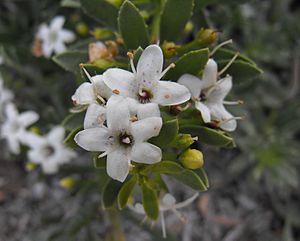Creeping boobialla facts for kids
Quick facts for kids Creeping boobialla |
|
|---|---|
 |
|
| Myoporum parvifolium at San Diego Botanic Garden | |
| Scientific classification | |
| Genus: |
Myoporum
|
| Species: |
parvifolium
|
| Synonyms | |
|
|
Myoporum parvifolium, often called creeping boobialla, is a cool plant that spreads out low to the ground. It's part of the figwort family, which is a group of flowering plants. This plant is special because it only grows naturally in southern Australia, including Flinders Island. It has long stems that trail along the ground and pretty white, star-shaped flowers.
Contents
What Creeping Boobialla Looks Like
Creeping boobialla is a shrub that grows flat on the ground. It can spread out to cover an area about 3 meters (10 feet) wide, like a mat. Its leaves are thick and smooth, without any hairs. They are usually about 18 to 40 millimeters (0.7 to 1.6 inches) long and 3 to 6.5 millimeters (0.1 to 0.3 inches) wide. The leaves are shaped like an egg, but narrower at the bottom.
They grow in an alternating pattern along the stem. Sometimes, the edges of the leaves near the tip have a few small teeth, like a saw. You might also see small, raised bumps, like warts, on the surface of the leaves.
Its Flowers and Fruit
White flowers with purple spots grow where the leaves meet the stem. They appear either alone or in small groups of 2 or 3. Each flower sits on a stalk that can be from 7.5 to 33 millimeters (0.3 to 1.3 inches) long.
Each flower has 5 pointed parts called sepals, which protect the bud. It also has 5 petals that are joined together at their base to form a short tube, about 3 millimeters (0.1 inches) long. The petal tips spread out and are blunt, about 3 to 4 millimeters (0.1 to 0.2 inches) long. This makes the whole flower about 7.5 millimeters (0.3 inches) across.
Inside the flower, there are 4 stamens, which are the parts that produce pollen. These stamens stick out beyond the petals. Creeping boobialla usually blooms from winter to summer in New South Wales. In South Australia, it flowers from October to March. After the flowers, the plant produces juicy, round fruits that are yellowish-white and can be up to 8.5 millimeters (0.3 inches) wide.
How It Got Its Name
The Science Behind the Name
The plant Myoporum parvifolium was first officially described by a botanist named Robert Brown in 1810. He wrote about it in his book called Prodromus Florae Novae Hollandiae.
The second part of its scientific name, parvifolium, comes from two Latin words. Parvus means "small," and folium means "leaf." So, parvifolium simply means "small-leaved," which describes its leaves well!
Where Creeping Boobialla Grows
Creeping boobialla is found naturally in the southwestern part of New South Wales. It also grows from the Eyre Peninsula in South Australia all the way east into Victoria. You can often see it growing along the Murray River in South Australia.
This plant likes to grow on limestone cliffs, along flat areas near rivers, and in woodlands. It prefers sandy soils, which can sometimes be a bit salty.
Using Creeping Boobialla in Gardens
A Great Ground Cover
Creeping boobialla is a very useful plant for gardens, especially as a "ground cover." This means it spreads out and covers the ground, which can help stop weeds from growing and keep the soil moist. Many people grow it for this reason.
It grows best in a sunny spot with soil that drains water well. However, it's a tough plant and can handle most conditions. Gardeners usually grow new plants from cuttings, which are small pieces taken from an existing plant. It has even been used as a "rootstock" for other related plants, like Eremophila. This means the roots of the creeping boobialla are used to help other plants grow.

